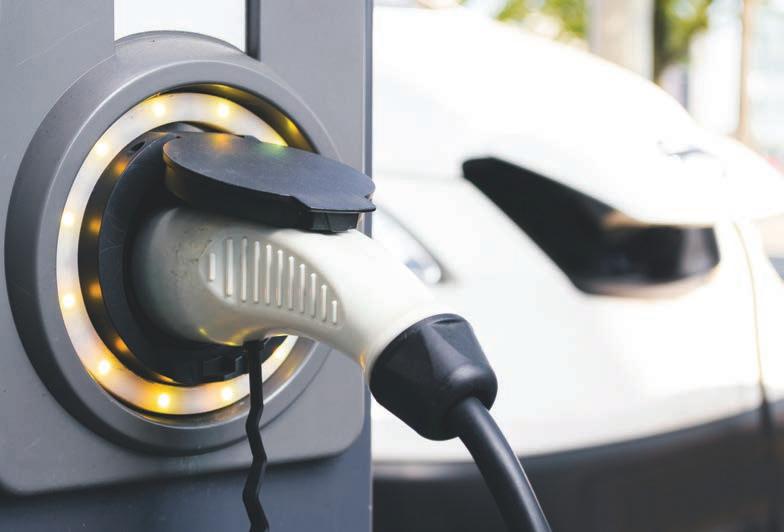
5 minute read
STORE FEATURE
Will you have a fleet of electric vehicles some day? More to the point, will your fleet have the juice to deliver?









Orchestrating
energy By Anne Mellano
Amazon recently announced the order of 100,000 electric vans to be delivered by 2030. For perspective, that’s more vehicles than FedEx currently uses worldwide. The fleet world is increasingly enamoured with electric vehicles, particularly business like the auto parts distribution industry, where quick reliable delivery is a key differentiator.
Of the many points of discussion around autonomous electric vehicles and the services they’re expected to deliver, one underrepresented topic is the battery capacity of electric vehicles and the limitations this imposes.
Most autonomous vehicles, in the long term, are expected to be electric for several reasons. Electric drive trains require less maintenance than their gas counterparts. The fuel is less expensive than gasoline. And they are easier to refuel without human intervention.
But electric vehicle batteries are still subject to variations of range and power that introduce new variables for fleet orchestration.
More than Just Range Vehicle range is usually the first topic that comes to mind when it comes to electric vehicles. How far can the vehicle travel? But that is a tricky issue because the range is impacted by a number of factors, some of them completely unrelated to sheer distance.
As with a gas-powered vehicle, electric vehicles use more power as their speed increases. Autonomous vehicles use energy as they process data, and the computers driving the cars process some 11 terabytes of data per day by some estimates.
Battery capacity is also influenced by temperatures. Lithium, the type of battery most electric vehicles currently use, doesn’t like cold, and some AV shuttle services have been forced to shut down during cold weather. Air conditioning is another power drain – much to the chagrin of an agency in Rhode Island that found its shuttles were not equipped with air conditioning and had to keep them garaged during summer heatwaves.
Vehicle weight (influenced by heavy cargo like engine components, and dense automotive parts) is another factor in energy use.
And depending on the local topography, there will be limits to the steepness of the grades that some vehicles can climb due to power constraints. the vehicle have the juice to complete a mission. Does it have enough battery power to reach a charging station after the mission? Where is the nearest charging station? Are there any hills or other energy intensive features of the route? How many vehicles are already waiting to be charged? How long can a vehicle afford to wait before it runs out of power?
Those are the issues on the front side of autonomous vehicle refueling. On the backside are questions like, when will a vehicle that is being charged return to service? Where should it be positioned in the event that there are no current ride requests near the charging station?
Service design issues The location and capacity of charging stations will also be important considerations in service design. The

right vehicle with the right mission. Included in the “more” are the considerations of surrounding demand and predicted future demand. Operators must make sure that there is always enough supply on hand and in the right locations to meet demand within defined service levels and operator utilization requirements.
All of this demonstrates why fleet orchestration is going to be a big part of your future fleet considerations. The goal of fleet orchestration is all about sending the right mission to the right vehicle at the right time.
Most mobility providers aim to carry as much paying cargo as possible while driving the fewest vehicles and kilometers. Companies that own their fleets and pay drivers by the hour want to make the most of every vehicle-km. Deadheading – the time traveling empty – incurs costs
No two rides are alike As a result, choosing a vehicle that will work for your business is going to be a complicated process.
It has become clear that no two rides consume the same amount of battery power.
Vehicle energy availability becomes an even bigger issue when it comes to managing on-demand mobility services with electric vehicles. When moving commercial packages, if there are constraints like guaranteed delivery times or wait times, a vehicle’s battery strength is one of the many variables that need to be considered when deciding what vehicle to send at what time.
The crucial question will always be does number of vehicles, their cargo space, and service area dimensions, as well as the geography will be limited by the proximity and capacity of charging depots. Because each mission will consume different amounts of energy on every trip, this data has to be monitored and factored into every dispatch in real-time.
Energy use and availability are just two of the factors that make fleet orchestration so complex. For deliveries, the locations of every request; the weight and composition of the cargo; the available vehicles; their locations; their status; the traffic conditions; road conditions; weather; geography; the wait times and more will all factor into matching the without revenue. Structuring the delivery circuit to maximize revenue will be what it’s all about.
For autonomous vehicle services, using electric vehicles battery power will play a critical role in assigning missions to vehicles… and it’s an important service constraint that needs to be factored into when maximizing fleet performance and fleet orchestration.
ANNE MELLANO A recognized expert in mobility services, and a cofounder of transportation management company Bestmile. She is director of global management activities, including identifying business opportunities and overseeing the company’s marketing and communications.










